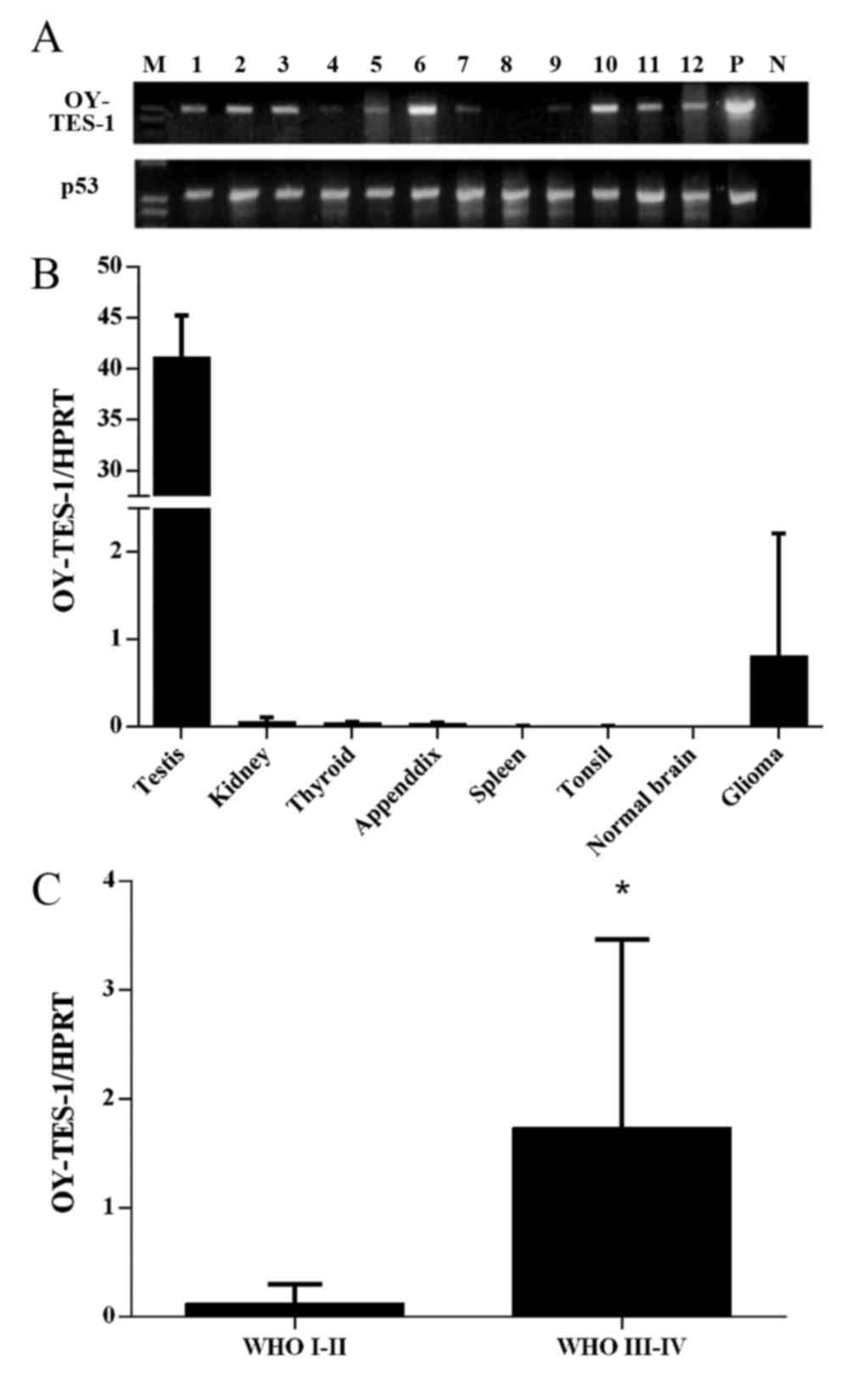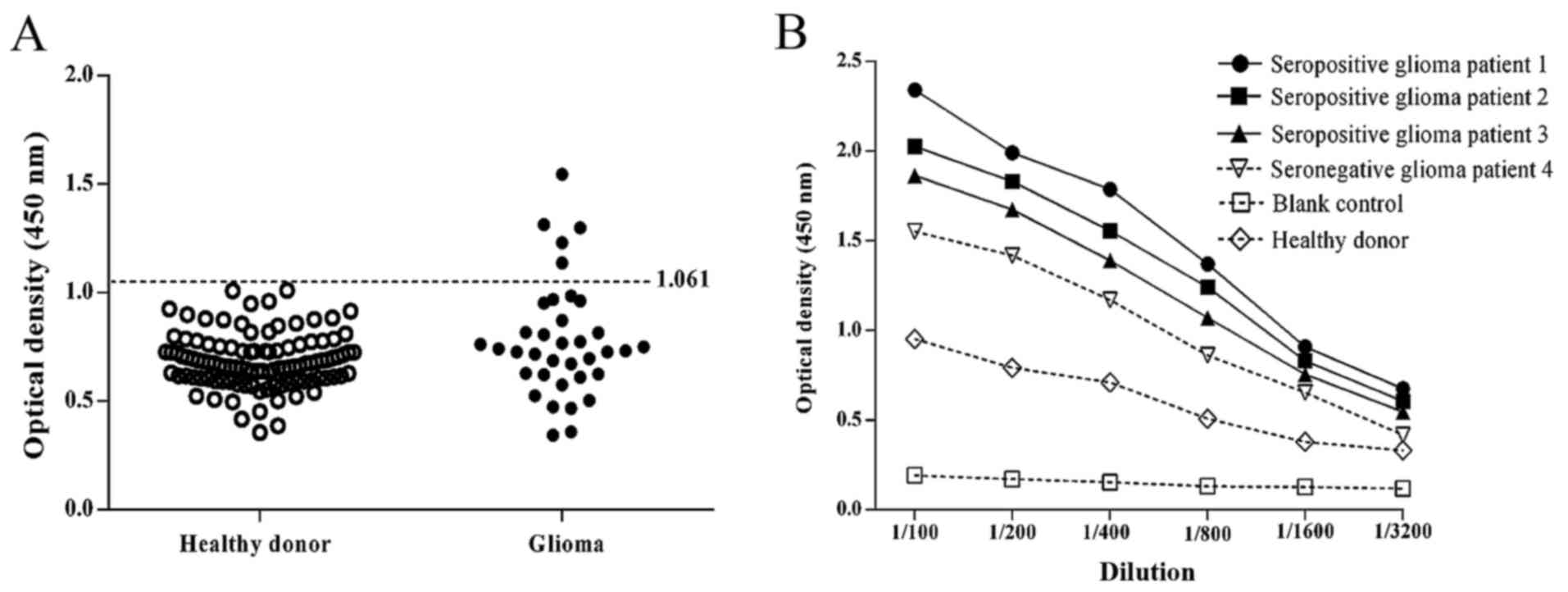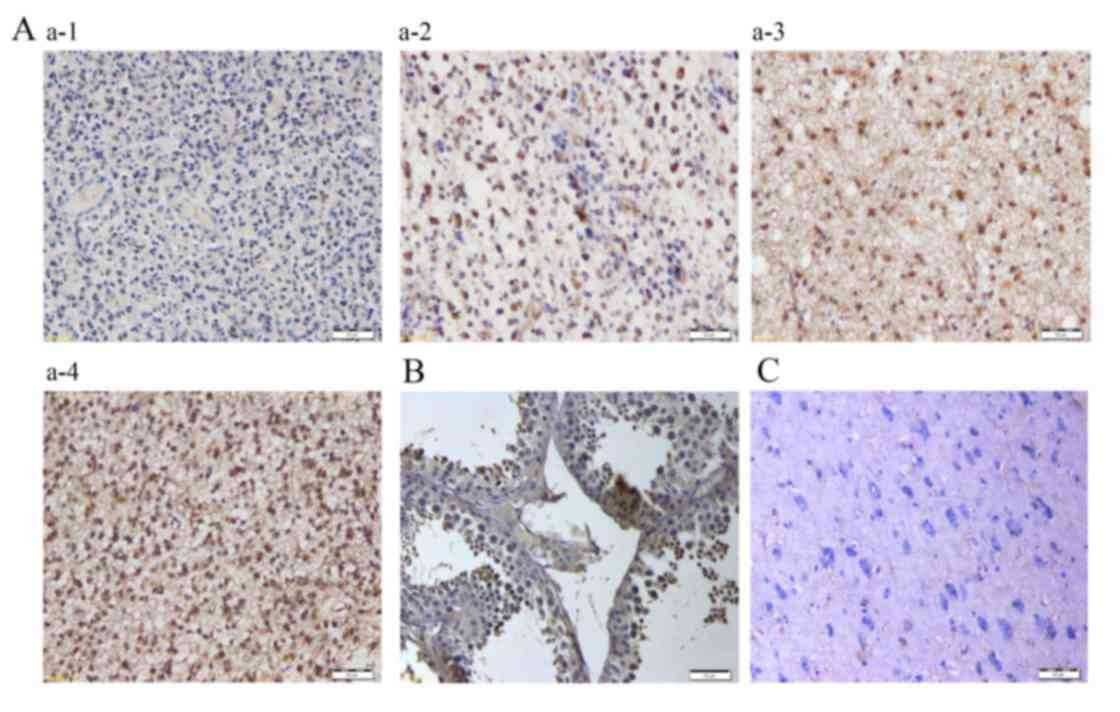|
1
|
Ostrom QT, Gittleman H, Liao P, Rouse C,
Chen Y, Dowling J, Wolinsky Y, Kruchko C and Barnholtz-Sloan J:
CBTRUS statistical report: Primary brain and central nervous system
tumors diagnosed in the United States in 2007–2011. Neuro Oncol.
16:(Suppl 4). iv1–iv63. 2014. View Article : Google Scholar : PubMed/NCBI
|
|
2
|
Naydenov E, Tzekov C, Minkin K, Nachev S,
Romansky K and Bussarsky V: Long-term survival with primary
glioblastoma multiforme: A clinical study in bulgarian patients.
Case Rep Oncol. 4:1–11. 2011. View Article : Google Scholar : PubMed/NCBI
|
|
3
|
Oike T, Suzuki Y, Sugawara K, Shirai K,
Noda SE, Tamaki T, Nagaishi M, Yokoo H, Nakazato Y and Nakano T:
Radiotherapy plus concomitant adjuvant temozolomide for
glioblastoma: Japanese mono-institutional results. PLoS One.
8:789432013. View Article : Google Scholar
|
|
4
|
Ehtesham M, Black KL and Yu JS: Recent
progress in immunotherapy for malignant glioma: Treatment
strategies and results from clinical trials. Cancer control.
11:192–207. 2004.PubMed/NCBI
|
|
5
|
Zendman AJ, Ruiter DJ and Van Muijen GN:
Cancer/testis-associated genes: Identification, expression profile,
and putative function. J Cell Physiol. 194:272–288. 2003.
View Article : Google Scholar : PubMed/NCBI
|
|
6
|
Scanlan MJ, Simpson AJ and Old LJ: The
cancer/testis genes: Review, standardization, and commentary.
Cancer Immun. 4:12004.PubMed/NCBI
|
|
7
|
Kalejs M and Erenpreisa J: Cancer/testis
antigens and gametogenesis: A review and ‘brain-storming’ session.
Cancer Cell Int. 5:42005. View Article : Google Scholar : PubMed/NCBI
|
|
8
|
Caballero OL and Chen YT: Cancer/testis
(CT) antigens: Potential targets for immunotherapy. Cancer sci.
100:2014–2021. 2009. View Article : Google Scholar : PubMed/NCBI
|
|
9
|
Fratta E, Coral S, Covre A, Parisi G,
Colizzi F, Danielli R, Nicolay HJ, Sigalotti L and Maio M: The
biology of cancer testis antigens: Putative function, regulation
and therapeutic potential. Mol Oncol. 5:164–182. 2011. View Article : Google Scholar : PubMed/NCBI
|
|
10
|
Okumura H, Noguchi Y, Uenaka A, Aji T, Ono
T, Nakagawa K, Aoe M, Shimizu N and Nakayama E: Identification of
an HLA-A24-restricted OY-TES-1 epitope recognized by cytotoxic
T-cells. Microbiol Immunol. 49:1009–1016. 2005. View Article : Google Scholar : PubMed/NCBI
|
|
11
|
Yao J, Caballero OL, Yung WK, Weinstein
JN, Riggins GJ, Strausberg RL and Zhao Q: Tumor subtype-specific
cancer-testis antigens as potential biomarkers and
immunotherapeutic targets for cancers. Cancer Immunol Res.
2:371–379. 2014. View Article : Google Scholar : PubMed/NCBI
|
|
12
|
Freitas M, Malheiros S, Stávale JN, Biassi
TP, Zamunér FT, de Souza Begnami M, Soares FA and Vettore AL:
Expression of cancer/testis antigens is correlated with improved
survival in glioblastoma. Oncotarget. 4:636–646. 2013. View Article : Google Scholar : PubMed/NCBI
|
|
13
|
Ono T, Kurashige T, Harada N, Noguchi Y,
Saika T, Niikawa N, Aoe M, Nakamura S, Higashi T, Hiraki A, et al:
Identification of proacrosin binding protein sp32 precursor as a
human cancer/testis antigen. Proc Natl Acad Sci USA. 98:3282–3287.
2001. View Article : Google Scholar : PubMed/NCBI
|
|
14
|
Baba T, Niida Y, Michikawa Y, Kashiwabara
S, Kodaira K, Takenaka M, Kohno N, Gerton GL and Arai Y: An
acrosomal protein, sp32, in mammalian sperm is a binding protein
specific for two proacrosins and an acrosin intermediate. J Biol
Chem. 269:10133–10140. 1994.PubMed/NCBI
|
|
15
|
Luo B, Yun X, Fan R, Lin YD, He SJ, Zhang
QM, Mo FR, Chen F, Xiao SW and Xie XX: Cancer testis antigen
OY-TES-1 expression and serum immunogenicity in colorectal cancer:
Its relationship to clinicopathological parameters. Int J Clin Exp
Pathol. 6:2835–2845. 2013.PubMed/NCBI
|
|
16
|
Fu J, Luo B, Guo WW, Zhang QM, Shi L, Hu
QP, Chen F, Xiao SW and Xie XX: Down-regulation of cancer/testis
antigen OY-TES-1 attenuates malignant behaviors of hepatocellular
carcinoma cells in vitro. Int J Clin Exp Pathol. 8:7786–7797.
2015.PubMed/NCBI
|
|
17
|
Fan R, Huang W, Luo B, Zhang QM, Xiao SW
and Xie XX: Cancer testis antigen OY-TES-1: Analysis of protein
expression in ovarian cancer with tissue microarrays. Eur J
Gynaecol Oncol. 36:298–303. 2015.PubMed/NCBI
|
|
18
|
Tammela J, Uenaka A, Ono T, Noguchi Y,
Jungbluth AA, Mhawech-Fauceglia P, Qian F, Schneider S, Sharma S,
Driscoll D, et al: OY-TES-1 expression and serum immunoreactivity
in epithelial ovarian cancer. Int J Oncol. 29:903–910.
2006.PubMed/NCBI
|
|
19
|
Louis DN, Ohgaki H, Wiestler OD, Cavenee
WK, Burger PC, Jouvet A, Scheithauer BW and Kleihues P: The 2007
WHO classification of tumours of the central nervous system. Acta
Neuropathol. 114:97–109. 2007. View Article : Google Scholar : PubMed/NCBI
|
|
20
|
Gure AO, Chua R, Williamson B, Gonen M,
Ferrera CA, Gnjatic S, Ritter G, Simpson AJ, Chen YT, Old LJ and
Altorki NK: Cancer-testis genes are coordinately expressed and are
markers of poor outcome in non-small cell lung cancer. Clin Cancer
Res. 11:8055–8062. 2005. View Article : Google Scholar : PubMed/NCBI
|
|
21
|
Cen YH, Guo WW, Luo B, Lin YD, Zhang QM,
Zhou SF, Luo GR, Xiao SW and Xie XX: Knockdown of OY-TES-1 by RNAi
causes cell cycle arrest and migration decrease in bone
marrow-derived mesenchymal stem cells. Cell Biol Int. 36:917–922.
2012. View Article : Google Scholar : PubMed/NCBI
|
|
22
|
Livak KJ and Schmittgen TD: Analysis of
relative gene expression data using real-time quantitative PCR and
the 2(−Delta Delta C(T)) method. Methods. 25:402–408. 2001.
View Article : Google Scholar : PubMed/NCBI
|
|
23
|
He SJ, Gu YY, Yu L, Luo B, Fan R, Lin WZ,
Lan XW, Lin YD, Zhang QM, Xiao SW and Xie XX: High expression and
frequently humoral immune response of melanoma-associated antigen
D4 in glioma. Int J Clin Exp Pathol. 7:2350–2360. 2014.PubMed/NCBI
|
|
24
|
Froger A and Hall JE: Transformation of
plasmid DNA into E. coli using the heat shock method. J Vis
Exp. 253:2007.
|
|
25
|
Almeida LG, Sakabe NJ, deOliveira AR,
Silva MC, Mundstein AS, Cohen T, Chen YT, Chua R, Gurung S, Gnjatic
S, et al: CTdatabase: A knowledge-base of high-throughput and
curated data on cancer-testis antigens. Nucleic Acids Res.
37:D816–D819. 2009. View Article : Google Scholar : PubMed/NCBI
|
|
26
|
Yang P, Wang Y, Peng X, You G, Zhang W,
Yan W, Bao Z, Wang Y, Qiu X and Jiang T: Management and survival
rates in patients with glioma in China (2004–2010): A retrospective
study from a single-institution. J Neurooncol. 113:259–266. 2013.
View Article : Google Scholar : PubMed/NCBI
|
|
27
|
Sahin U, Türeci O, Schmitt H, Cochlovius
B, Johannes T, Schmits R, Stenner F, Luo G, Schobert I and
Pfreundschuh M: Human neoplasms elicit multiple specific immune
responses in the autologous host. Proc Natl Acad Sci USA.
92:11810–11813. 1995. View Article : Google Scholar : PubMed/NCBI
|
|
28
|
Fischer U, Struss AK, Hemmer D, Pallasch
CP, Steudel WI and Meese E: Glioma-expressed antigen 2 (GLEA2): A
novel protein that can elicit immune responses in glioblastoma
patients and some controls. Clin Exp Immunol. 126:206–213. 2001.
View Article : Google Scholar : PubMed/NCBI
|
|
29
|
Struss AK, Romeike BF, Munnia A,
Nastainczyk W, Steudel WI, König J, Ohgaki H, Feiden W, Fischer U
and Meese E: PHF3-specific antibody responses in over 60% of
patients with glioblastoma multiforme. Oncogene. 20:4107–4114.
2001. View Article : Google Scholar : PubMed/NCBI
|
|
30
|
Pallasch CP, Struss AK, Munnia A, König J,
Steudel WI, Fischer U and Meese E: Autoantibodies against
GLEA2 and PHF3 in glioblastoma:
Tumor-associated autoantibodies correlated with prolonged survival.
Int J Cancer. 117:456–459. 2005. View Article : Google Scholar : PubMed/NCBI
|
|
31
|
Scanlan MJ, Chen YT, Williamson B, Gure
AO, Stockert E, Gordan JD, Türeci O, Sahin U, Pfreundschuh M and
Old LJ: Characterization of human colon cancer antigens recognized
by autologous antibodies. Int J Cancer. 76:652–658. 1998.
View Article : Google Scholar : PubMed/NCBI
|
|
32
|
Weller M, Bornemann A, Ständer M, Schabet
M, Dichgans J and Meyermann R: Humoral immune response to p53 in
malignant glioma. J Neurol. 245:169–172. 1998. View Article : Google Scholar : PubMed/NCBI
|
|
33
|
Cheever MA, Disis ML, Bernhard H, Gralow
JR, Hand SL, Huseby ES, Qin HL, Takahashi M and Chen W: Immunity to
oncogenic proteins. Immunol Rev. 145:33–59. 1995. View Article : Google Scholar : PubMed/NCBI
|
|
34
|
Yamanaka R, Tanaka R and Saito T:
Immunohistochemical analysis of tumor-infiltrating lymphocytes and
adhesion molecules (ICAM-1, NCAM) in human gliomas. Neurol Med Chir
(Tokyo). 34:583–587. 1994. View Article : Google Scholar : PubMed/NCBI
|
|
35
|
Preuss KD, Pfreundschuh M, Weigert M,
Fadle N, Regitz E and Kubuschok B: Sumoylated HSP90 is a dominantly
inherited plasma cell dyscrasias risk factor. J Clin Invest.
125:21792015. View
Article : Google Scholar : PubMed/NCBI
|
|
36
|
Grass S, Preuss KD, Wikowicz A, Terpos E,
Ziepert M, Nikolaus D, Yang Y, Fadle N, Regitz E, Dimopoulos MA, et
al: Hyperphosphorylated paratarg-7: A new molecularly defined risk
factor for monoclonal gammopathy of undetermined significance of
the IgM type and Waldenstrom macroglobulinemia. Blood.
117:2918–2923. 2011. View Article : Google Scholar : PubMed/NCBI
|
|
37
|
Chen YT, Scanlan MJ, Sahin U, Türeci O,
Gure AO, Tsang S, Williamson B, Stockert E, Pfreundschuh M and Old
LJ: A testicular antigen aberrantly expressed in human cancers
detected by autologous antibody screening. Proc Natl Acad Sci USA.
94:1914–1918. 1997. View Article : Google Scholar : PubMed/NCBI
|












